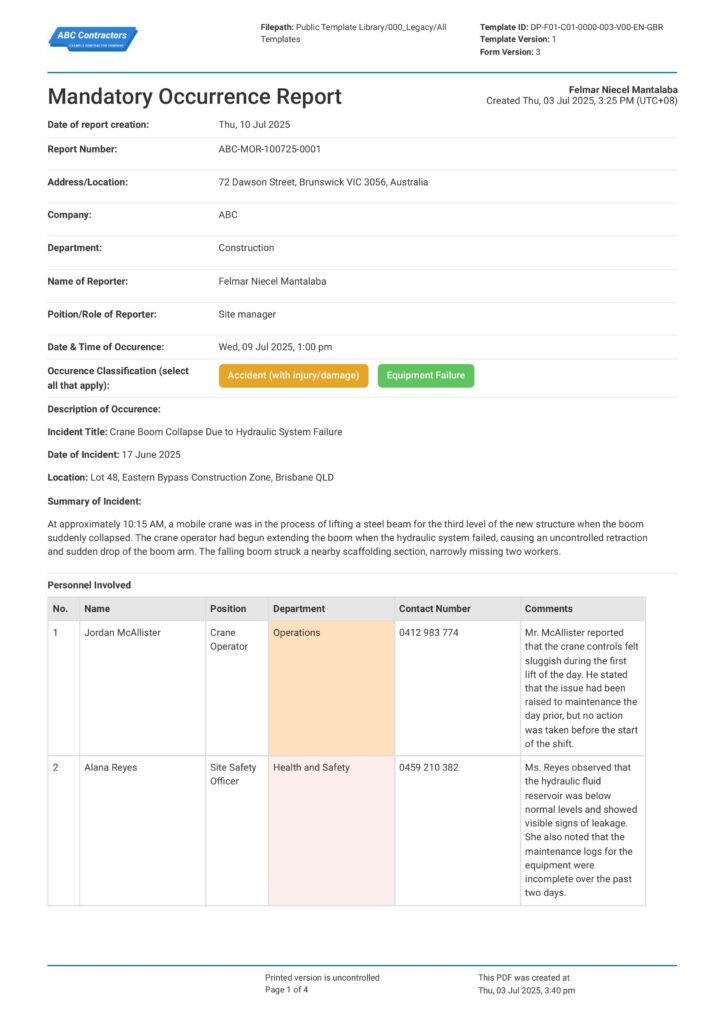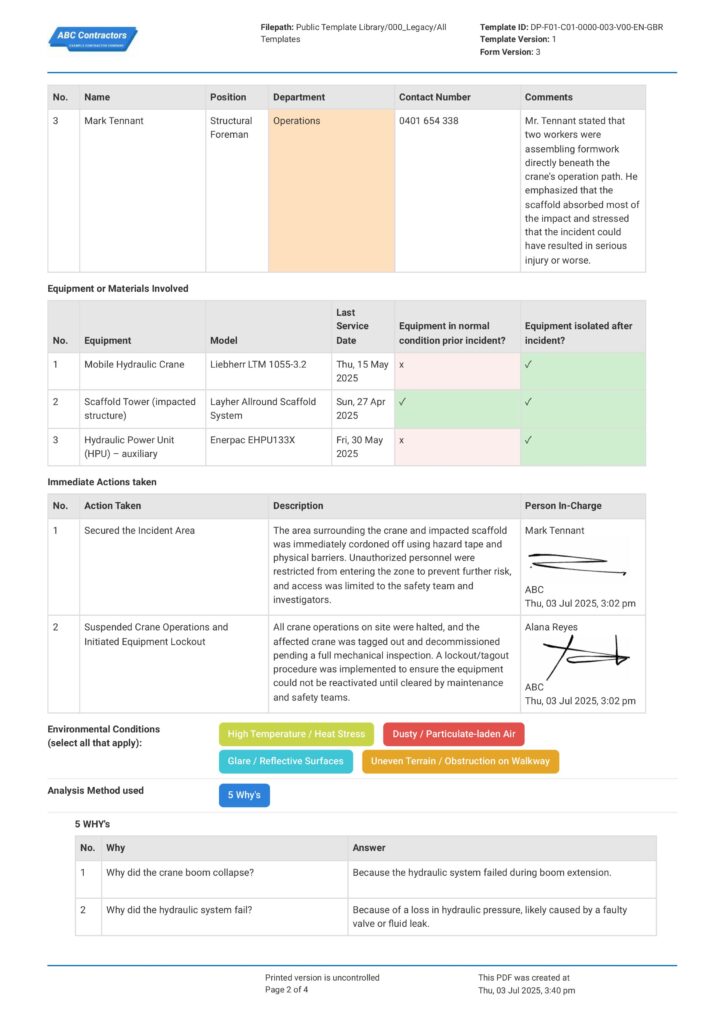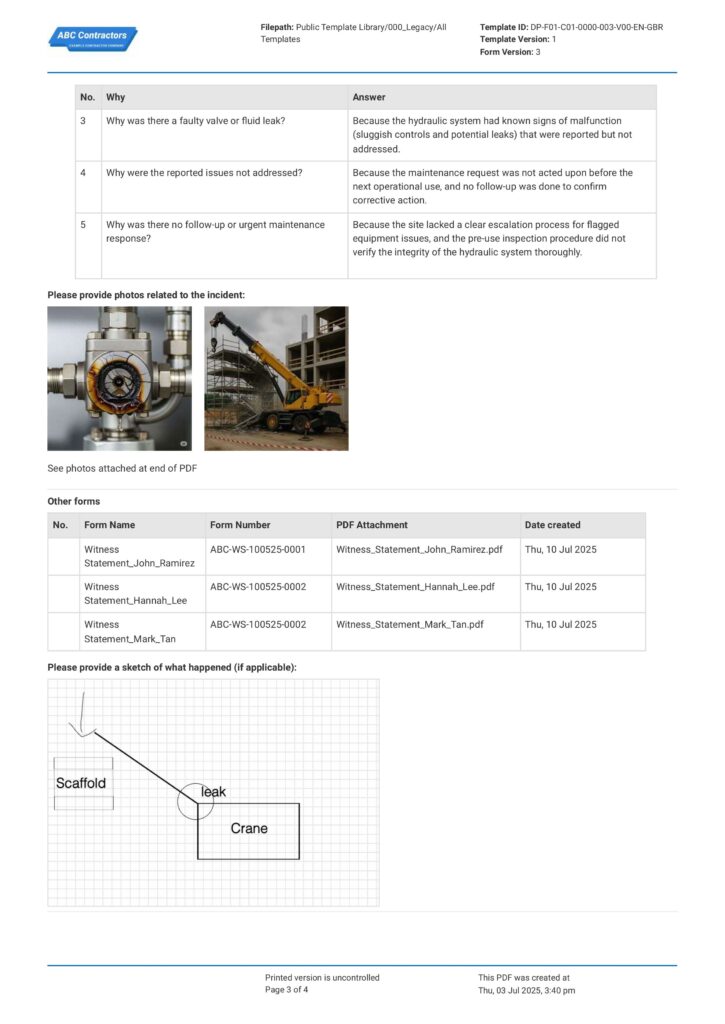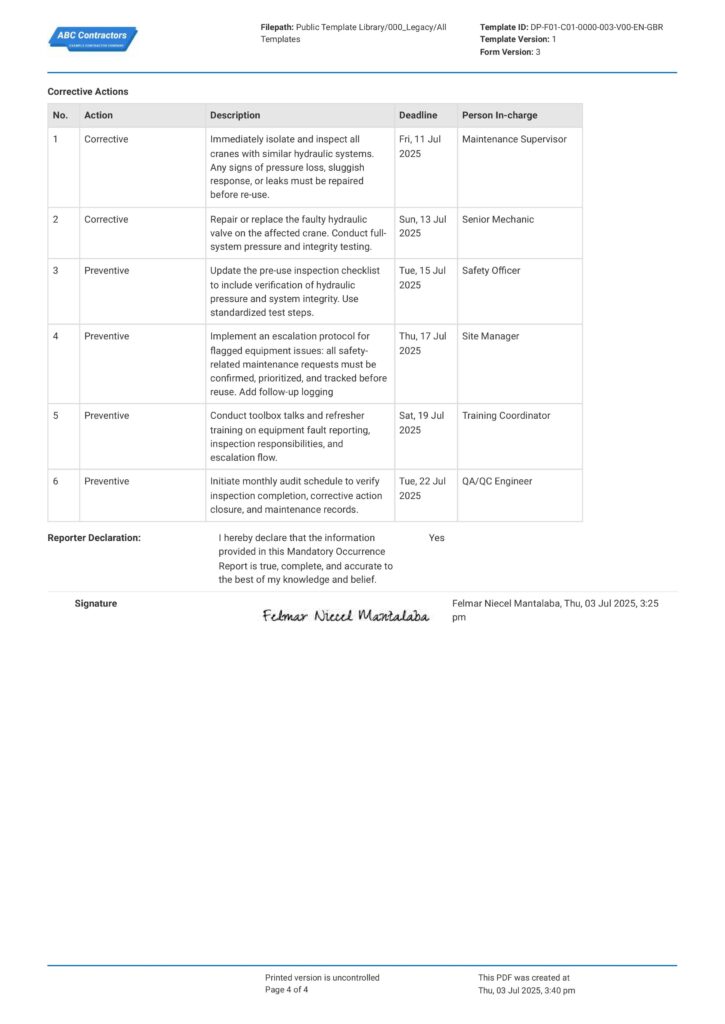Article Page – The Golden Thread Building Safety Act
The Golden Thread UK Building Safety Act
In this article, we will cover The Golden Thread Building Safety Act. We go through what it is, the usefulness of its approach throughout the lifecycle of a higher-risk building, the challenges of its compliance for existing buildings with legacy systems, and how to comply using useful guides and free resources.

Table of Contents
Article Summary
- The Golden Thread of information was included in the Building Safety Act in 2022 following an independent review after the Grenfell Tower fire catastrophe last 2017. It serves as the backbone for proper building safety documentation – how to gather, maintain, and share dynamic and live safety documents.
- The Golden Thread - Accountable Person Handover is a straightforward and professional form to put into summary the record of documents handed over to the next duty holder.
- Complying with the Golden Thread of Information can be done in two practical ways following a master list of documents and using a reliable information management system.
How is the Golden Thread framework relevant for the Building Safety Act?
The Golden Thread framework is an important backbone on how building safety information should be gathered, maintained, and shared – which is a crucial factor and role for the UK Building Safety Act of 2022. The framework ensures that data is dynamic and live, meaning a continuous flow of up-to-date information, maintaining well-informed and safety-focused duty-holders and regulators at every stage of the building (from design, construction, occupation, and after that).
This Golden Thread framework becomes even more relevant when used for higher-risk residential buildings. When living documents are properly collected, used, enforced, and traced, companies and businesses can avoid the damaging consequences of safety documentation gaps.
How are UK Building Safety documents formatted under the Golden Thread framework?
The Golden Thread framework formats UK Building Safety documents to be clear, properly-structured, and easily format-ready. There's no mandated structure, however documents must support accessibility, traceability, and incorporates version control.
Below is an example of the Golden Thread - Accountable Person Handover. This can help you get started. While the law does not require a standard format, you will need a clear, neat and professional form to record all the documentation handed over to the accountable person before the occupation stage.
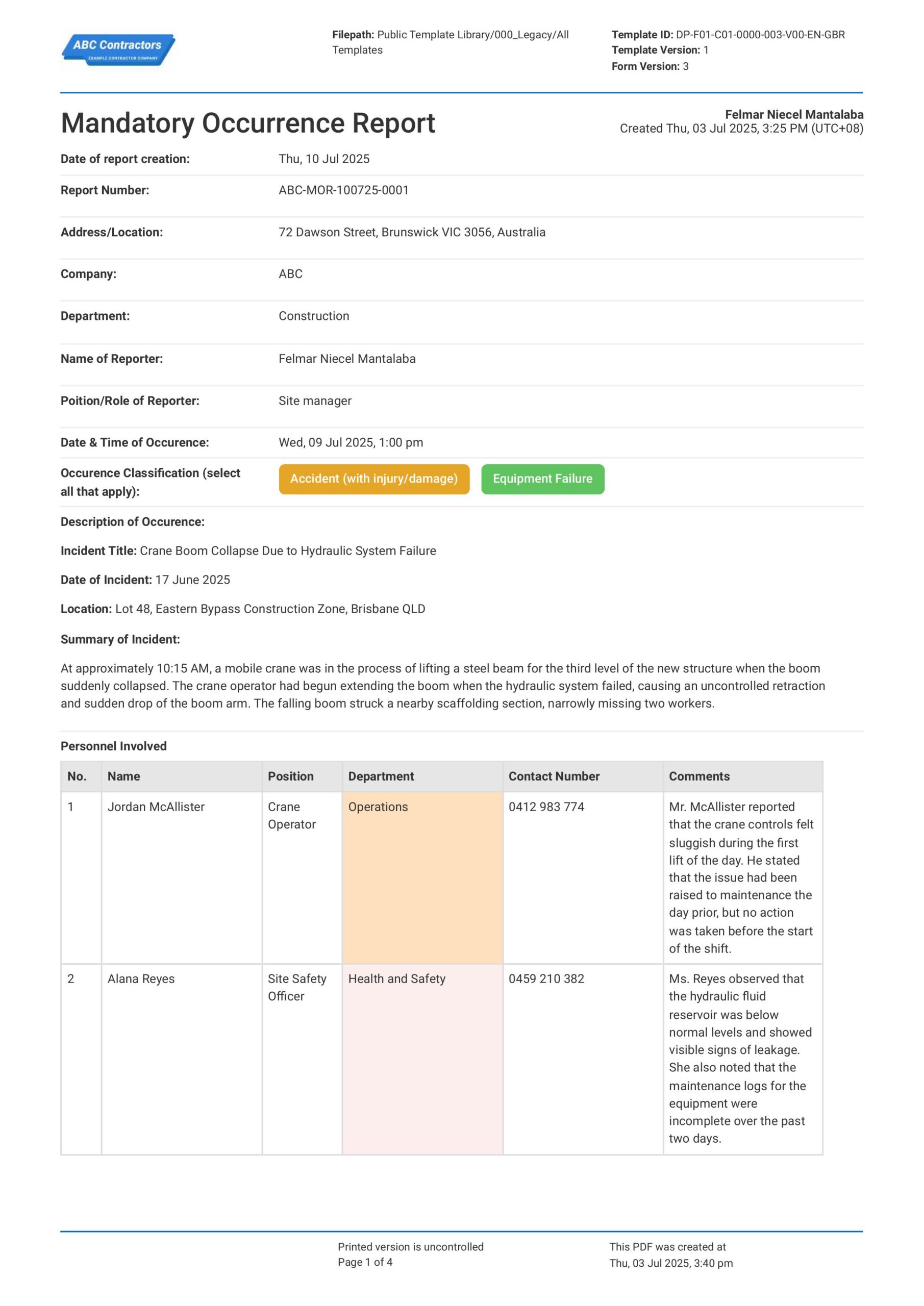
Use this Mandatory Occurrence Report for free
The Golden Thread Building Safety Act
The Golden Thread is a thread of information relevant to building safety, design, and construction. It was introduced in the UK Building Safety Act in 2022 and was legally enforced in 2023. The Golden Thread acts as a “single source of truth” in matters of executing legal obligations and incident investigation.
This legal requirement is adapted from a metaphor of a golden thread that links and connects everything together, which, in construction, means connecting all information from design to occupancy.
The Golden Thread Building Safety Act requires a full digital record of obligations starting before building work begins, to be continuously updated throughout design and construction, and to be handed to the Accountable Person(s) when the building work is completed. It must be kept securely and treated as the building’s definitive reference and be readily usable and accessible when needed especially on critical situations such as after an accident or incident or during an investigation by the Building Safety Regulator.
What is Golden Thread approach used for?
The golden thread approach is used for securing and tracing information in designing and construction for higher-risk buildings (HRB).
HRBs are defined by the UK government that are buildings that are 7 storeys or are at least 18 meters high and buildings that have 2 residential units and these are registered by the Building Safety Regulator (BSR).
Legally, it is only required for HRBs, but there are increasing interest to leverage it as well for non-high risk building as a best practice.
It’s such a catchy title, in fact Oxford Dictionaries defines golden thread as “an idea or feature that is present in all parts of something, holds it together, and gives it value.”
And if you think about it, you will observe how it exists throughout the key stages in the lifecycle of a higher-risk building, where BSR’s regulatory inspections are done. Below are the gateways and the specific golden thread information that is required to be submitted.
Gateway One
Planning stage or before the construction starts, once a building is commissioned, the Designer will create a Fire Statement with the Fire Engineer input to show that fire safety has been considered and included in the planning stage. This is then the first document to be part of the golden thread of information and is submitted to the Local Planning Authority.
Gateway Two
Pre-construction stage or prior to the building work, when essential documents are submitted regarding functional requirement and appropriate safety management. At this stage it’s a ‘hard stop’ and no construction can start unless developers meet regulations. At this stage, the Principal Designer or Principal Contractor must create the Design Intent, Construction Control Plan and Competence Declarations and the Client (building owner) keeps them which the Building Safety Regulator
Gateway Three
Post-construction, pre-occupation stage. At this point, all Golden Thread must be handed to the building owner or what is called an Accountable Person (AP) that has the legal duty to manage building safety risks in a higher-risk building (HRB).
Occupation Stage
When all the critical information is gathered and verified in each stage or gateways, this forms the foundation of the Golden Thread and becomes a living trail and documentation during the occupation stage. Here, the AP is required to maintain an accurate, up-to-date Golden Thread documents such as Building Information Record, Fire Safety, Control Logs, Safety Case Report, Resident Emergency Strategy, Maintenance and Inspection Records and other relevant documentation required by the Building Safety Act.
Golden Thread of Information Building Safety Act: Core Duties
The Golden Thread Building Safety Act – How it started:
The golden thread concept was emphasized after Dame Judit Hackitt, a former chair of the UK Health and Safety Executive, made an independent public review entitled “Building a Safer Future” following the catastrophic fire that happened in Grenfell Tower last 2017. In this incident, 72 people died and tagged as the worst UK residential fire since WWII. The theory that most experts strongly supported for the fast spreading of the fire is the existence of polyethylene material in the cladding and insulation, which is a highly combustible plastic. There was no record of whether the building has met its fire safety requirements, no clear review of the materials used, and there is no comprehensive. In short, the golden thread was not practiced as it was not legally applicable then.
In her report, Hewitt emphasized the need for a continued and determined focus on improvements and refurbishments or material alterations in buildings, not just on new build. Creating a golden thread of information about each high-risk residential buildings and obligating the creation of digital records from initial design intent to construction until occupation, including any changes. She writes,
“if there is just a focus on new build, the required improvement in safety in all existing high-rise residential buildings will not be achieved.”
Intending that existing building should continuously meet current regulations on building safety. The government accepted the recommendation of Hackitt and drafted a construction golden thread in 2021 the building safety bill, and then it was added in the building safety act in 2022.
The Golden Thread Building Safety Act - What it means now:
The golden thread guidance provides a list of responsibilities that accountable persons must oblige to in terms of information they must keep:
- Health and Safety File
- Building Safety Case Report
- Resident Engagement Strategy
- Mandatory Occurrence Reporting System
Let’s look at each responsibility and how it functions within the golden thread of information.
Health and Safety File
The Health and Safety File comes from the Construction (Design and Management) Regulations 2015 (CDM Regulations) are a collection of documentation of design and management regulation used and prepared at the end of construction or Gateway 3 and handed over to the client or building owner. This was established before the golden thread concept as a main requirement for developers included in the building safety act however it is often left out, and it remained static as the time went by. However, ideally, the health and safety file should be updated frequently after substantial alterations.
Here are resources that further discuss CDM Regulations, which laid the foundation for the structured safety documentation for a building's design and construction period. CDM Regulations Construction Phase Plan and CDM Compliance Form.
Building Safety Case Report
A Building Safety Case Report is a documentation for higher-risk buildings prepared before or during building occupancy. This report is a requirement for Building Assessment Certificate. It will lay out all the safety risks particularly on the spread of fire or smoke, and structural risks in the building and the current safety measures to manage those risks by people responsible of the building such as the PAP or building owner or building safety manager.
The Building Safety Case Report should be kept live and updated during significant changes of the building structure and any changes on the safety risk. This is updated whenever the regulator requests it and is stored as part of the Golden Thread.
Resident Engagement Strategy
Resident Engagement Strategy comes in during the occupation phase and is prepared by the principal accountable person (PAP) early in occupation. This is basically a document that details the level of involvement of the residents and owners of the residential units in making building safety decisions and how they are informed about these decisions.
It is required by law, specified under Building Safety Act 2022 Section 91, that PAPs must prepare a Strategy and promote the participation in it to the residents.
The principal accountable person demonstrates this participation by providing a copy of this document, and it must be kept in the golden thread of information and, in verbatim, “must review the strategy from time to time.” Additionally, one practical way of proving compliance is to have a Resident Safety Engagement Log that records the actual participation of the residents.
If you’re an AP who needs to make a resident engagement strategy, it just needs to be straightforward and practical. The desired flow of engagement for example: in the event of fire, the residents according to the written Resident Engagement Strategy must be well-informed of the building’s fire strategy and evacuation routes, they must know their responsibilities such as keeping escape routes clear and their smoke alarms must be tested.
Mandatory Occurrence Reporting System
After construction, when the golden thread is live and exists as an easy updatable filing system, duty holders also need to uphold a responsibility to maintain Mandatory Occurrence Reporting (MOR) system which is a mechanism to report specific safety occurrences of actual incidents or near misses and record all critical safety data about a building. MORs are also legal requirements included in the Building Safety Act 2022 and these reports are added into the Golden Thread of information once occupancy of the building begins.
Basically, every occurrence reported using a Mandatory Occurrence Report form becomes part of the safety record and triggers investigation and possible enforcement.
This system was adapted to adapt a coherent approach to reporting issues. MOR must show capability to report, record and assess safety occurrences identified, and all these incidents are promptly reported to the Building Safety Regulation (BSR).
With this, it is recommended to create your MOR system in a reliable software in a software such as Dashpivot with its proven qualities and features that is perfect both for keeping a golden thread of information and all its included documentation.
Complying with The Golden Thread Building Safety Act
The Golden Thread of Information’s intention and purpose is grounded and the fact that it is coming from a professional independent review of an expert following from the Grenfell Tower fire catastrophe last 2017 made its inclusion to the Building Safety Act have an important mark towards having greater accountability to fire safety accidents in the UK. This also makes keeping a golden thread of information not only for compliance but simply a best practice in construction business.
To confirm a building’s compliance with the Golden Thread of Information, the verification is in place and checked throughout the whole lifecycle from design to occupancy. During gateway approvals, the application of the Building Assessment Certificate, and during regular audits or after every incident you need to report to the BSR. With this, there are two practical ways you can rely on for compliance: first is having a guided master list of documents and second is having a reliable information management system.
Master List of Documents for The Golden Thread Building Safety Act
Is there a master document list for the Golden Thread of Information? One might ask. A master document list would make it easier indeed to comply and faster to go through. In the Building Safety Act, it does not spell out a list of documents necessary for the golden thread in one place or one section in the Act. Section 88-90 explains the requirements for the information that must be kept for the Higher-Risk Building.
However, just recently in May 2025 the Building Safety Alliance, a cross-industry coalition with 100 collaborative groups of representatives from residents, professions and industry, has also published the Golden Thread Toolkit including the Master Document List and assurance methodology aligned to the legal requirements, these documents according to the BSA, can be used to identify the key data which needs to be specified for the golden thread information requirements.
This master list of documents and its alignment to the Building Safety Act closes the gap between legal duties and real-world practice. In short, it supports a structure to the golden thread. This toolkit would be ideal to have especially because it promotes uniformity with other complying representatives.
Reliable information management system
Building Safety Act Regulation 6 specified the manner in which the golden thread of information should be kept specifically:
- that it should be in electronic form;
- structured;
- information is capable of being shared;
- electronically with the regulator and other persons, and;
- easy to retrieve and integrity is maintained
With all this, there should be a reliable information management system or software that is capable of handling all of this. More than just storage choosing a reliable system should not only have a structured storage that can put documents in a digital folder and tag in categories but also must support faster retrieval, access and sharing. Access should also be secured meaning that you can choose who can view, edit and have workflow capabilities.
Challenges to keep up with the compliance of Golden Thread
Despite its benefits, maintaining a complete and accurate Golden Thread comes with significant challenges, even though it is intended to be straightforward and relatively easy to follow for new buildings constructed after its inclusion in the Building Safety Act. The challenge, however, is for old buildings with legacy documentation. According to this study from PBC Today, 70% of asset owners struggle with building safety and maintenance due to contrasting systems and legacy data, and only 27% reported that their asset information was fully digital and manageable for statutory compliance.
It’s also challenging for existing building owners in the UK to locate crucial information, let alone keep it in one filing system and ensure that project data is consistent and accurate, especially because they could not get a good start during the design or pre-construction stage. There are also alarming knowledge gaps on Building Safety Act responsibilities, according to a survey that showed more than half of respondents were unsure or had no idea about duty holder responsibilities for Higher Risk Buildings (HRBs), and this is coming from experienced workers on HRB projects.
Streamlining Golden Thread compliance with digital tools under the UK Building Safety Act
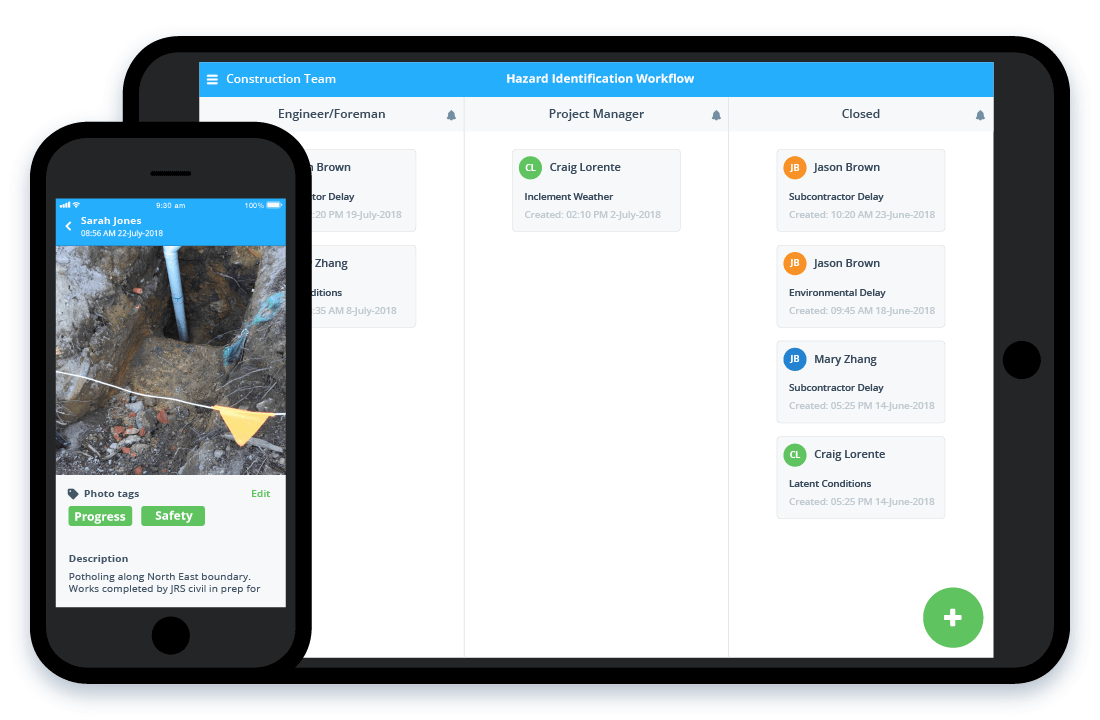
The Golden Thread framework already explicitly requires that building safety information should be:
- Digital
- Secure
- Updated
- Easily accessible
The UK Building Safety Act, as mandated under the Golden Thread, encourages the use of digital solutions however possible for duty holders to maintain accurate, easily accessible, conforming to dynamic and live documentation, and continuously updated information all throughout the lifecycle of a building.
Digital solutions like this Construction Project Management App including all other free resources like this Mandatory Occurrence Report and this Building Safety Case Report.
Golden Thread of Information: A Summary
The golden thread of construction is aimed at keeping a neat trail of sources of documents and records. It is a digital record-keeping system of required documents from each stage in the lifecycle of a higher-risk building (HRB). The stages in each lifecycle are called gateways one, two, and three before the occupation stage of the residents of the building.
The golden thread of information fosters a proactive approach to resolving fire and structural issues by using it as a “single source of truth” and an authoritative reference in solving them, one major inclusion that was not part of previous building catastrophes. The golden thread approach also pushes liability to the building owners assigned by law as accountable persons and makes designers or engineers accountable as well for the materials used in construction during the new build and as refurbishments arise. During occupancy, it endorses building safety for the residents as it ensures their involvement and awareness of decisions relating to safety during occupancy.
Despite its challenges with existing buildings with legacy data and a gap in training and knowledge regarding duty holder responsibilities, it remains a strong and worthy addition towards progressive and safe building construction and maintenance.
Frequently Asked Questions
Is it required by Building Safety Act to keep the Golden Thread digitally?
Yes - the Golden Thread of Information needs to be stored digitally and managed in a structured manner. It is a core requirement as per the UK Building Safety Act.
How can Sitemate's Dashpivot support compliance for Golden Thread?
Sitemate's Dashpivot can fully support the golden thread of information a new or existing building by its advance features for structured storage, a no-code document builder for the required documentation each stage in the build, reduce compliance risk and easier location and file sharing within the team and the Building Safety Regulator. Dashpivot can fully meet the expectations of the Golden Thread framework – transparent and easily accessible documents that handle version control and promote accountability among duty-holders.
Does Sitemate offer templates for Building Safety Case Reports?
Yes - Sitemate offers editable and even immediately ready-to-use templates for UK Building Safety Act compliance, that can also be catered to fit for your workflow. Companies in the construction industry, most especially dealing with high-risk building, use UK Building, MOR, and Golden Thread templates readily available in our library.
Related resources

Mandatory Occurrence Report
Comply with regulations, and document occurrences in the workplace using this report

Building Envelope Inspection Checklist
Detail and log issues and concerns of the building envelope with this inspection checklist.

Building Safety Case Report
Easily manage risks and comply with UK Building Safety Act regulations with this convenient safety case report.
